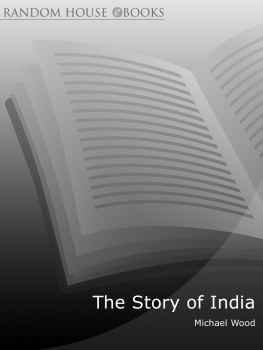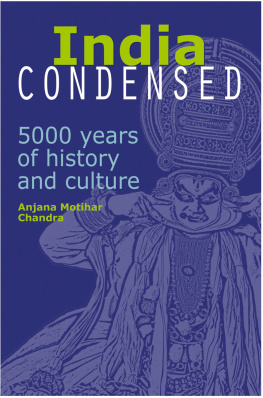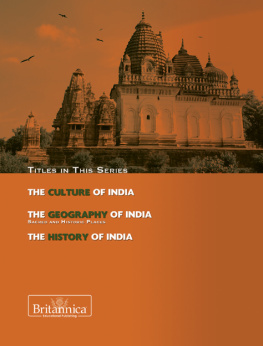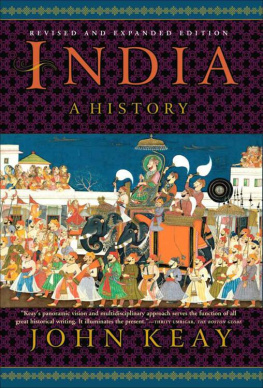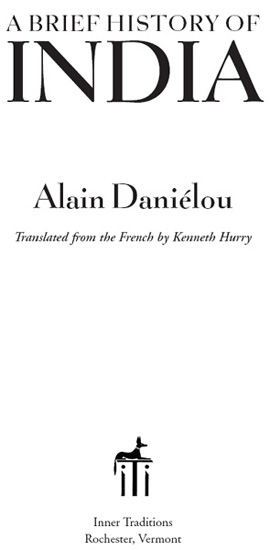
Preface
The various languages of India contain very few chronicles that can be actually considered historical, except for relatively recent periods. Howeverowing to its situation, social system, and the continuity of its civilizationIndia is itself a sort of history museum, with its separate departments preserving the cultures, races, languages, and religions that have come into contact over its vast territory, without ever mixing together or destroying each other. No invader has ever entirely eliminated the culture of the more ancient peoples, and new beliefs and knowledge have never supplanted the beliefs and knowledge of former times.
In this strange country, we may even today encounter Stone Age peoplesmariners who sew their boats together because they are unfamiliar with the use of metals, civilizations whose technology has remained at what we usually term prehistoric levelsand yet these civilizations have preserved their languages, customs, traditions, philosophy, and religion down to our own time. The mysterious and ancient Dravidian civilization exists side by side with the other evolutionary levels of the great Indo-Aryan civilization that came from the north. In India the latter became the Sanskrit culture that coexists today with considerable vestiges of Iranian, Greek, Scythian, Parthian, Chinese, Tibetan, Mongolian, Persian, Arab, and European influences. In India too we find ancient forms of Judaism, survivals of primitive Christianity, and Parsis who found refuge from an Islamized Iran.
The inexperienced observer is surprised by this profusion of races, languages, and different customs, and finds it difficult to unravel the threads of this tangled maze. At the same time, a more profound study makes it easy to place each group and every aspect of life in its original context. Recognizing the tiny cultural islands surviving from periods almost forgotten elsewhere but which have been miraculously preserved in India can occasionally throw an astonishing light on the history of other parts of the world.
If we wish to understand India and utilize the facts, we must approach it using different methods from those we might employ for another country. This is because the history of India is not merely a chronologya series of accounts of battles, conquests, and palace revolutions. It rests only momentarily on dynastic lists that appear ephemeral beside the permanence of its institutions. Indias history is too long and too vast for the events of any particular period to play a definitive role, and Hindus have never given much importance to passing events. The history of Indiawith its discoveries in the fields of science, arts, technology, social structures, religions, and philosophical conceptsis the history of humankind, of our own human nature.
In its distant past, India was not an isolated country, as it has sometimes been in more recent centuries. The significant factors in Indias historysuch as major invasions, the expansion of successive civilizations, and the efforts of the human mind to discover the inner nature of the worldhave often come from the same sources that have forged the history of other peoples, and give us a glimpse of what our own prehistory may have been like. At times, the history of India takes us from the isles of Oceania to the shores of the Atlantic. Owing to a curious phenomenon of the Indian spirit, the various currents meeting on Indian soilinstead of destroying or replacing each otherbecome fixed on their arrival in this magic land. They remain unchanging, side by side, in an extraordinarily eternal environment, where evolution appears to have halted and where events belonging to civilizations elsewhere separated by thousands of years appear to be almost contemporary.
The details of many of the views on Indias ancient history adopted in the first section of this study are still disputed today, although on the whole they are in line with the views of historians who have sought a general idea of the human adventure. We must not forget that the concept of dividing the history of the various peoples into compartments arose at a time when the Western world refused to believe in humankinds antiquity. At the end of the eighteenth century, very few scholars including geologists were prepared to accept that the world was much older than 4,004 BC according to the interpretation of the Old Testament. Even at the end of the nineteenth century, the theosophist Bishop Lightfoot, following Kepler, calculatedapparently without covering himself with ridiculethat the world had been created at 9 A.M. on 23 October 4004 B.C.E. My own uncle, the cur of Saint-Pierre-de-Chaillot, affirmed at the beginning of the twentieth century that since God is almighty, there was nothing to stop him from creating the world with corpses in it, to explain away prehistorical discoveries in apparent contrast to the articles of faith, which today have been prudently forgotten.
The conclusions reached by geology, archaeology, and prehistorical studies have not so far managed to correct our historical concepts inherited from the nineteenth century. Even though such concepts are built on erroneous data and on absolutely unjustifiable short-term evolutionary conceptions, they have been considered as established fact, in the name of which all Indian documents that contradict these theories have been rejected as works of fantasy. We should now take them up again. At no levelwhether religious, linguistic, artistic, or philosophichas there been any perceptible evolution developing from elementary primitive forms during the few thousands of years that we deem historical. History that does not take into account the heritage of older civilizations more or less purposely forgotten will never be more than fiction with a falsely scientific basis.
According to H. D. Sankalia, What was once believed to be prehistory has now come into the range of history. Thus both in Egypt and Mesopotamia history commences around 3,000 B.C. So it will be in India... when the Indus script is deciphered.
India provides us with the most surprising documents about this protohistorical period and previous periodsliterary and archaeological documents, as well as living documents, miraculously preservedthrough which we can relive forgotten ages and comprehend the origin and nature of our beliefs, rites, institutions, and languages, the invention of which is often arbitrarily attributed to much later periods and civilizations. As a result, the latter are given an unmerited importance, providing a wholly unjustifiable and puerile image of the barbarity and ignorance of earlier periods.
The history of India covers so vast a period of time that it is impossible to provide a complete picture. I have consequently sought to focus on certain salient points as being characteristic of various eras, while merely indicating events or periods which are seemingly less significant.
PART ONE
Origins
The First Civilization: The Proto-Australoids
The study of the first peoples of India reveals that technology and civilization are not always synonymous. Human beings, living under extremely simple material conditions, have actually developed the social institutions, and the religious, philosophical, and artistic concepts that are the very foundation of modern civilizations, often to such a level of refinement and with such an intuition of the realities of the visible and invisible world that our own conceptions may in comparison appear infantile and really primitive. The introduction of writing was preceded by vast periods of civilization, reflection, and knowledge transmitted by oral tradition. The resultant beliefs, social systems, and knowledge are still being transmitted, writing having merely fixed certain aspects at a given period. The Hebrew prophets and Vedic sages belonged to civilizations of a kind we currently term prehistoric, with extremely organized and efficacious systems of oral transmission. This is why oral transmission is the only means deemed valid by Brahmans with regard to the Vedic hymns, the most ancient of which are the work of poets and sages who knew nothing of writing. The sacred nature of oral transmission has survived, even though some texts were written more than four thousand years ago. Great importance is attributed to oral tradition among all peoples, including Westerners, and the Celts in particular. Even today, the words of consecration in the Catholic Church are only considered efficacious if they are transmitted orally. A study of those populations that, in India, have refused the usage of writing, agricultural developments, and any change in their social institutions and beliefs is essential before measuring the very relative contribution made by more recent civilizations.
Next page



